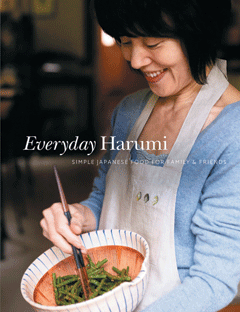
November 26, 2009
Delicious Reads
Metropolis rounds up hot cookbooks for the cold season
By Metropolis
Originally published on metropolis.co.jp on November 2009

By Harumi Kurihara
(Conran Octopus, 2009, 192pp, ¥3,098)
This new work by the doyenne of Japanese cookbook authors will be welcomed by everyone who loves washoku. Everyday Harumi is filled with easy-to-cook, home-style recipes that cover a wide range of meat, seafood and vegetable dishes.
The book opens with an entire chapter on cupboard essentials for making Japanese cuisine, in particular sauces that you will go back to often: ponzu, men-tsuyu, and vinegar with mirin.
Among the basic recipes are chicken karaage, shoga-yaki (ginger pork) and classic vegetable dishes like tofu salad with sesame dressing. Kurihara has also adapted a few recipes so that they’re easier to prepare with ingredients found in the Western kitchen—watercress, celery and cauliflower. There’s even an udon dish with a ground-meat miso sauce that could be mistaken for pasta bolognese.
Even if you’re a collector of Japanese cookbooks, you’ll be pleasantly surprised by the new recipes to be discovered in Everyday Harumi. Bonus: the food is presented in lovely Japanese pottery and other traditional vessels.

By Takashi Yagihashi with Harris Salat
(Ten Speed Press, 2009, 168pp, ¥2,401)
Takahashi Yagihashi has been a chef and restaurateur in the American Midwest for two decades. In 2000, he was named one of America’s Ten Best New Chefs by the prestigious Food & Wine magazine, and in addition to his namesake restaurant in Chicago, he’s been collaborating with Macy’s department store on a nationwide chain of noodle shops.
This book is packed with recipes for common noodles like ramen, soba, udon and somen, as well as pasta and other Asian varieties. There are also popular appetizers often found at izakaya, like gyoza, yakitori, braised pork belly (which can also be used in ramen dishes) and shumai.
Yagihashi has covered all the noodle bases, including a thorough collection of ramen dishes: chilled, tantan-men, miso and even tsukemen (noodles served separate from the broth). There are cold somen dipping sauces like shiso-ume, yuzu and tomato, plus dishes like curry udon and hearty duck Namban soba that will keep you warm throughout the winter. The pasta recipes include that Japanese standby, spaghetti with spicy mentaiko; another, based on onsen tamago (soft-boiled egg), is Yagihashi’s twist on classic carbonara.

By Tadashi Ono and Harris Salat
(Ten Speed Press, 2009, 150pp, ¥2,406)
Finally—a book on nabe in English. Chef Tadashi Ono of Matsuri restaurant in New York and journalist-blogger Harris Salat of the Japanese Food Report have teamed up for the definitive guide to Japan’s quintessential comfort food.
The first chapter deconstructs the basic parts of a good nabe: broth and dashi; foundational ingredients like Napa cabbage, daikon, Japanese mushrooms and tofu; seasonings such as miso; and yakumi (condiments) like ponzu and yuzu kosho. There are helpful suggestions on how to incorporate shime, the rice or noodles added to the hotpot as the traditional end of the meal.
Recipes include classics like mizutaki (chicken and vegetables), yudofu (tofu) and the sumo wrestler’s staple, chanko nabe. Readers in Japan who want to try the book’s regional dishes are fortunate to have access to esoteric ingredients like ishiri fish sauce from the Noto peninsula or the grilled rice “logs” of Akita (kiritampo). Japanese Hot Pots is so easy to follow that you may soon find nabe becoming a regular part of your repertoire. And vegetarians, don’t despair—there are plenty of meatless recipes to keep you well fed through the winter.

By Masanobu Fukuoka
(The New York Review of Books, 2009, 184pp, ¥1,535)
First published in English 30 years ago, this little green tome by Masanobu Fukuoka has been reissued by The New York Review of Books as part of its Classics series. And the timing couldn’t be better—as issues of sustainability, agribusinesses and the use of chemical fertilizers have come to the fore, the book is more relevant than ever.
Fukuoka (1913-2008) was a farmer who employed radical methods to grow his crops, like cultivating rice in dry fields and not weeding by tillage. (The title comes from his innovative system of spreading straw in gardens.) This compact work puts forth his opinions and chronicles the success he enjoyed with these and other practices. There are also interesting and informative mandala-like diagrams showing seasonal Japanese produce and seafood.
Anyone who supports the Slow Food movement, enjoys working in a garden, or is concerned with sustainability will treasure The One-Straw Revolution—and most likely share it with many friends. Fukuoka’s book beautifully conveys his belief in eating healthful, natural food, and in doing so reminds us that an egg should taste like an egg.







